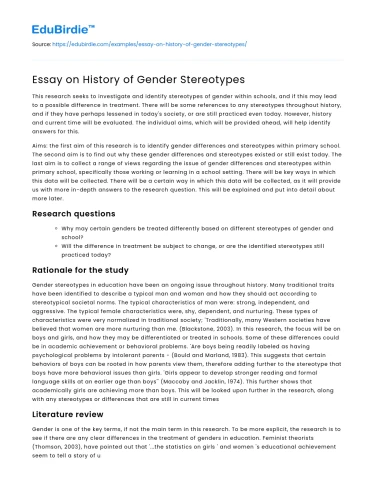This research seeks to investigate and identify stereotypes of gender within schools, and if this may lead to a possible difference in treatment. There will be some references to any stereotypes throughout history, and if they have perhaps lessened in today's society, or are still practiced even today. However, history and current time will be evaluated. The individual aims, which will be provided ahead, will help identify answers for this.
Aims: the first aim of this research is to identify gender differences and stereotypes within primary school. The second aim is to find out why these gender differences and stereotypes existed or still exist today. The last aim is to collect a range of views regarding the issue of gender differences and stereotypes within primary school, specifically those working or learning in a school setting. There will be key ways in which this data will be collected. There will be a certain way in which this data will be collected, as it will provide us with more in-depth answers to the research question. This will be explained and put into detail about more later.
Research questions
- Why may certain genders be treated differently based on different stereotypes of gender and school?
- Will the difference in treatment be subject to change, or are the identified stereotypes still practiced today?
Rationale for the study
Gender stereotypes in education have been an ongoing issue throughout history. Many traditional traits have been identified to describe a typical man and woman and how they should act according to stereotypical societal norms. The typical characteristics of man were: strong, independent, and aggressive. The typical female characteristics were, shy, dependent, and nurturing. These types of characteristics were very normalized in traditional society; 'Traditionally, many Western societies have believed that women are more nurturing than me. (Blackstone, 2003). In this research, the focus will be on boys and girls, and how they may be differentiated or treated in schools. Some of these differences could be in academic achievement or behavioral problems. 'Are boys being readily labeled as having psychological problems by intolerant parents - (Bould and Marland, 1983). This suggests that certain behaviors of boys can be rooted in how parents view them, therefore adding further to the stereotype that boys have more behavioral issues than girls. 'Girls appear to develop stronger reading and formal language skills at an earlier age than boys'' (Maccoby and Jacklin, 1974). This further shows that academically girls are achieving more than boys. This will be looked upon further in the research, along with any stereotypes or differences that are still in current times
Literature review
Gender is one of the key terms, if not the main term in this research. To be more explicit, the research is to see if there are any clear differences in the treatment of genders in education. Feminist theorists (Thomson, 2003), have pointed out that '...the statistics on girls ' and women 's educational achievement seem to tell a story of unmistakable progress. Here, it is shown that girls' academic achievement is being acknowledged, as opposed to how negatively it was acknowledged throughout history; specifically, the stereotypes put on female students at the time. Based on 2019 statistics from The National Education Union, over a third (34%) of primary school teachers say they witness gender stereotyping in their school on at least a weekly basis. Over half (54%) say they witness it on at least a termly basis. This shows that there is an inexplicable amount of stereotyping occurring in schools yet today. Adding onto this statistic, theorists, (Steffens and Jelene, 2011) found that girls ' mathematics self-concepts and their achievement were lower the stronger their mathematics-related gender stereotypes were. In contrast, boys ' mathematics achievements were higher the stronger their mathematics-related stereotypes were. These findings indicate that for girls, mathematics-related stereotypes can lead to negative self-beliefs and lessen motivation but also view their abilities negatively which may take a toll on their achievement. To further develop this opinion, theorists, (Passolunghi, Ferreira, and Tomasetto, 2014) documented that girls ' endorsement of math-related gender stereotypes is negatively associated with their ability beliefs. This shows that stereotypes hurt individuals, in this case, girls. The stereotypes lead to negative thinking towards one's academic and ability capability. This therefore provides us with a view that stereotypes can have negative effects, not only on being treated according to stereotypes, but also lead to an unhealthy amount of questioning their own ability and academic achievements.
The research focus will also be on boys, and how they may be disadvantaged due to certain factors or actions. There have been many encounters or theorists stating that boys are possibly more disadvantaged than girls, academically. Theorists (Jones,2020) stated that' although they (gender stereotypes) are often about girls and women, they shape the experiences of everyone The gender stereotypes that children encounter can influence physical and psychological well-being career choice, or perception of ability. These are some of the many factors that can hurt a child when encountering gender stereotypes. To further support the statement of boys being more disadvantaged, there is an article from the Guardian in 2019, with statistics to show the gender gap in education; 'The results, from the national curriculum tests and assessments taken by pupils in year six, known as Sats, showed 70% of girls reached the expected standards in math, reading, and writing, compared with just 60% for boys, widening the gap from 8% last year to 10% this year. This shows that the gap between boys and girls when looking at the overall average of test results, is widening. This could hurt boys emotionally, as seeing the results and gap could influence interpersonal and intrapersonal relationships, as well as access to equitable educational opportunities. This will be further researched after data has been collected and analyzed.






 Stuck on your essay?
Stuck on your essay?

